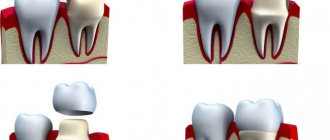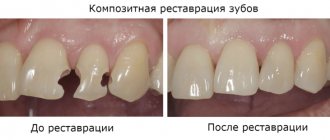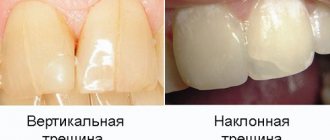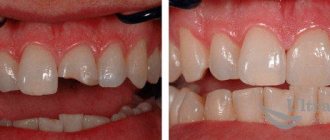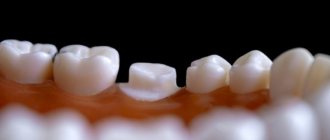Publication date: 08/03/2021
The loss of a front tooth is very acute. And this is not surprising. Even if there is a slight darkening of the enamel on the front incisors, the person already begins to feel uncomfortable - he is embarrassed to talk and smile. And the absence of even one tooth along the smile line only aggravates psychological discomfort. Therefore, such problems need to be solved as quickly as possible.
Prosthetics for anterior teeth
are primarily aimed at high aesthetics. Therefore, they use materials that effectively combine strength and high aesthetic characteristics. The Ilatan Clinic in Moscow uses various methods for restoring front teeth using advanced technologies and the latest generation materials. Treatment methods and cost depend on the clinical picture.
Problems arising from missing teeth
The absence of even one dental unit in a row leads to serious consequences:
- Due to the lack of lateral support, neighboring teeth begin to shift;
- if a tooth is lost along with the root, the bone tissue in this area begins to quickly atrophy and decrease;
- chewing function is impaired, which leads to problems with the gastrointestinal tract;
- the bite changes, which leads to deformation of the position of the jaw joint and dysfunction of the umbilical nervous system;
- The shape of the face changes, the upper lip begins to recede, and wrinkles appear.
The longer a tooth is missing, the more severe the consequences will be. If a tooth is lost in the smile area, patients are offered different options for restoring the dentition. The method depends on the clinical picture.
How tooth loss affects facial contours
Loss of teeth, especially complete ones, immediately affects a person’s appearance. Firstly, the height of the lower third of the face decreases due to the fact that the support of the lower jaw by the teeth is lost and the jaw moves back in the joint area, and forward and upward in the chin area.
The result is a so-called “senile face” - the distance between the tip of the nose and the top of the chin decreases. Due to this, the natural folds of the face deepen, the corners of the mouth droop, the red border of the lips decreases in width due to their displacement towards the oral cavity.
Losing teeth causes a decrease in the tone of facial muscles, the cheeks and chin tissues sag. Visually, the face looks more mature. Dental restoration sets the lower jaw in the correct position, provides support to soft tissues, and restores the smile. As a result, facial rejuvenation occurs, patients feel confident, and their quality of life improves significantly.
These changes are also possible with partial loss of teeth.
Especially in the case of chewing teeth. I have patients (women) who turned to a cosmetologist with a desire to improve their facial contours and eliminate sagging cheeks. In response to this, the doctor strongly recommends that the missing chewing teeth be restored first to provide soft tissue support and only then begins his own procedures. Because only in this case we get the most complete and long-lasting effect.
Aesthetic restoration of anterior teeth
If you need to correct the appearance and shape of incisors or fangs, the best solution is ultra-thin veneers or lumineers. Plates 0.2 - 0.3 mm thick made of ceramic or zirconium are fixed to the outside of the teeth, eliminating all visual defects, making the smile luxurious. Such microprostheses do not require significant intervention in the structure of the teeth. The enamel is prepared exactly to the thickness of the plate, and the veneers are fixed to the surface of the teeth using a special glue (bond). Typically, veneers are installed on 6-10 upper and 4-6 lower teeth along the smile line.
Prosthetics after tooth extraction and indications for the procedure
Installation of a denture allows you to completely restore the functional and aesthetic properties of the jaw apparatus. The indication for the procedure is single or multiple damage to the jaw as a result of trauma, surgical amputation due to advanced caries, or other diseases of the oral cavity.
If the crown is partially destroyed, a microprosthesis is installed instead of the usual one. This group includes inlays, veneers and ultraneers. The products effectively solve aesthetic problems with minimal trauma to natural bone and gum tissue.
If the front tooth is destroyed, but the root is preserved
In case of significant destruction of the coronal part (up to 50%), the front tooth can be restored using prosthetic crown. The affected tooth is depulped, followed by filling the canals, given the desired shape (prepared), if necessary, the root is strengthened with a stump insert. The crown is fixed onto the prepared stump using dental cement.
For the smile area, it is better to choose all-ceramic or metal-free crowns made of zirconium or aluminum oxide. These materials have a shade and degree of transparency similar to natural enamel. The doctor will select an option so that the restored tooth does not stand out in any way in the general row.
Installation of the prosthesis immediately after removal (within 24 hours)
Clients are always interested in how many days after an injury or surgery they can get dentures. Dentistry has express methods for instantly eliminating smile defects. There is no need to hide an ugly gap from others and experience discomfort when communicating! We are talking about simultaneous implantation, which is performed in one stage. The dentist installs an artificial root into the resulting hole and immediately puts on a crown, which is prepared in advance. It creates a load on the jaw apparatus and prevents atrophy.
Another option is immediate dentures, which are temporary and are designed for 3-4 months of use.
With complete absence of a tooth
Prosthetics for front teeth in the absence of them involves 2 main methods:
- Installation of a bridge prosthesis
- this method is suitable for replacing 1 to 4 missing incisors. A bridge is a structure of several connected crowns, 1-2 suspended in the center and 2 hollow on the sides, which are attached to adjacent supporting teeth. The main disadvantage of the method is the need to grind and often depulpate the supporting units, even if they are completely healthy. That is, if you need to restore 1 missing incisor, two adjacent ones will have to be injured. - Implant prosthetics
– technology allows you to restore any number of missing teeth in a row. An implant is implanted into the jawbone, which fully replaces the missing tooth root. After the implant has healed, an adapter (abutment) is installed on it, onto which an artificial crown is fixed, identical in shape and color to the natural tooth. If an entire segment of the dentition is missing (3 or more teeth), 2 artificial roots are implanted, onto which a bridge is fixed. - Prosthetics of the front tooth immediately after extraction
is performed using the express implantation method. Immediately after surgical removal of a tooth, an implant is screwed into its socket, an abutment and a temporary crown made of lightweight plastic are fixed onto it. The temporary crown is removed from the bite, does not take part in chewing, it is necessary only to preserve the aesthetics of the smile. After 2-3 months, when the implant has fused with the bone, the temporary prosthesis will be replaced with a permanent one made of durable, reliable material (metal-ceramics, zirconium, etc.).
Prosthetics on implants does not involve injury to neighboring units; implanted implants perform all the functions of a natural tooth root and prevent jawbone atrophy. Implants are implanted once and for all; only prosthetic structures are subject to replacement (if they break or end their service life).
What can lead to tooth loss
Tooth loss begins with periodontal disease.
The first cause of adentia is periodontitis.
The second reason for tooth loss is caries.
The next cause of tooth loss is pulpitis
Other causes of tooth loss include periodontitis and hypoplasia.
Another reason for the development of edentia is diabetes mellitus.
If tooth extraction was previously carried out in a patient with diabetes, then it is necessary to understand that diabetes in general accelerates the atrophy of tissues, bones, and all degenerative processes in the body: from vascular sclerosis to trophism of the limbs. And in this case, it also affects edentia.
Look at the example of one of the patients with insulin-dependent diabetes mellitus, how he developed atrophy. Of course, this does not happen instantly, over several years, but edentia is an inevitable fact, unfortunately:
The professional experience of the specialists of the German Implantology Center allows us to successfully solve even such, sometimes very complex problems associated with atrophy and edentia by performing bone grafting and sinus lifting with subsequent implantation:
This clinical case and its successful treatment are reviewed in more detail - HERE
That is, there are two main reasons for tooth loss:
The first is periodontal disease (periodontitis), the second is caries and its complications (pulpitis and periodontitis), hypoplasia.
There are other reasons, but they are, let’s say, quite exotic and “don’t make a difference.” At the moment, there is no consensus on why caries and periodontitis occur and how to prevent them.
There are many theories, but there is no single answer to the question of how to prevent the development of these diseases. In my opinion, this suggests that these are multifactorial processes that involve genetics, nutrition, hygiene, the nature of the area in which a person lives, and so on and so forth... Why am I saying this? And to the fact that the reasons for development are a separate topic for discussion and we will return to it later, but now let’s look at the consequences of tooth loss.
Consequences of edentia
A disease such as adentia has a huge number of negative consequences. A person is not able to clearly pronounce individual sounds, speech becomes slurred and unpleasant for others, it is very difficult for such people to find work in the field of social communications where constant communication is required. Some types of food, such as tough and hard foods, simply become inaccessible, since in order to bite off and thoroughly chew meat, you need a full set of teeth. Such a person is doomed to lifelong intake of liquid food. And if at first glance this problem does not seem so terrible, then it is worth considering it from a slightly different angle. Due to the lack of vitamins that the body must receive from solid food, after some time the patient begins to develop diseases of the stomach and intestinal tract, as well as the body as a whole. In this connection, the problem of edentia cannot be postponed until later.
The doors of YuliSTOM dental clinics in St. Petersburg are open 7 days a week!
You can both get advice and get rid of edentia in our dental clinics. Moscow metro station Zvezdnaya, Danube Avenue, 23
Prosthetics with a bridge structure
If the doctor and patient plan to install a dental bridge, then after extraction you will have to wait four to six weeks. This is the average time it takes for a hole to heal. Installation, fitting, and adjustment of a prosthesis are manipulations that can easily touch, injure, and infect healing tissues. Therefore, before they begin, the hole must be completely tightened.
After complex or multiple removals, healing time may increase. You will have to wait longer for prosthetics even if alveolitis has developed - an infectious inflammation of the tissues of the socket.
Orthopedic treatment of complete edentia
In case of complete edentia, the doctor can offer two main correction options: implantation followed by prosthetics or wearing a complete removable denture.
Removable dentures were very popular before the advent of implant prosthetics, accessible to a wide range of people. Now removable dentures are used, but are not considered the optimal solution to the problem. In modern dentistry, several types of removable dentures are used:
✔
acrylic;
✔
nylon.
Acrylic removable dentures consist of a solid base and attached artificial teeth. The lack of flexibility gives these prostheses several special qualities, which are both the main advantage and the main disadvantage. On the one hand, a solid base contributes to an even, healthy load on the entire jaw when chewing food. However, this same property makes the prosthesis more fragile and less comfortable to wear compared to more elastic structures. Acrylic dentures have a porous structure on which bacteria and plaque accumulate; the monomer in their composition can cause an allergic reaction. When choosing this design, we recommend paying attention to Acry Free prostheses, made from the latest type of plastic without toxic substances. They are more modern, durable and flexible, but their cost is higher than other acrylic prostheses.
Nylon prostheses are more flexible and aesthetic. They are made from hypoallergenic materials. However, they have insufficient rigidity, which affects the quality of chewing food and contributes to rapid atrophy of bone tissue. Because of this, nylon dentures made of polyurethane and other materials are not recommended for use in completely toothless jaws.
Prevention
To maintain healthy teeth for as long as possible, you need to eliminate the causes of tooth loss. To do this, just follow simple rules:
- brush your teeth thoroughly but gently;
- use dental floss;
- regularly have professional teeth cleaning;
- visit a doctor at least once every 6 months;
- to refuse from bad habits;
- establish a balanced diet;
- use protective mouthguards during training or extreme entertainment to avoid situations in which a tooth falls out.
When is a tooth root 100% subject to extraction?
Tooth root removal is performed if:
- the root is softened below the gum level,
- the root of the tooth is below the level of the surrounding bone tissue,
- the root of the tooth has cracks
:
- the root of the tooth is chipped
:
- the root of the tooth is severely damaged, for example as a result of canal treatment with resorcinol
:
- There are various inflammatory processes around the root and under the root of the tooth - cyst, cystogranuloma
:
- the root of the tooth is mobile,
- there is a deep dental pocket.
Implantation of long-extracted teeth
As mentioned earlier, prolonged absence of even one tooth can cause irreversible destruction of bone tissue. This is one of the most serious complications, due to which the implant cannot be securely fixed in the gum cavity and over time becomes loose or is completely rejected.
In this case, the part of the bone tissue that covers the implant on top will be too thin. This can lead to exposure of the top of the pin and loss of its functional properties. That is why installing an implant in place of a long-lost tooth is possible only after osteoplasty. The doctor will fill the void with a special substance, and after a few months he will make a final decision on the possibility of installing an implant.
Bone tissue augmentation can be carried out using several methods. Sinus lifting involves the use of the maxillary sinuses, the lower wall of which is slightly raised, and the resulting area is filled with bone material. Modern dentistry also uses methods of bone regeneration or osteoplasty and bone block transplantation.
previous post
After braces, teeth moved apart
next entry
Completely edentulous upper jaw
In case of partial absence of teeth, the prosthesis rests on the remaining units. If it is full, there is no such possibility of fastening, which may cause difficulties with the installation of the prosthesis. Therefore, dentures for the upper and lower jaws have significant design differences. Dentures for the upper jaw include a volumetric base that imitates the anatomy of the palate, which ensures a tight fit. To improve fixation, special gels are used. Dentures for the lower jaw do not require additional fastening elements, since they repeat its alveolar part.
Features of treatment
Complete dentures on implants can be removable or conditionally removable. Removable ones are used for mini-implantation. Conditionally removable dentures are removed only in the dentist's office.
In classical prosthetics on implants, different fastening methods are used.
- Push-button fixation
is carried out using abutments - equatorial or spherical. When the prosthesis is fixed, the lock is activated. With some force, the prosthesis can be removed for inspection and hygiene procedures. - Another method is beam fixation.
First, a beam is made to connect the already installed implants. The prosthesis itself is attached to it. Prosthetics using this method are more reliable, but more expensive. From a technical point of view, it is more difficult to carry out.

